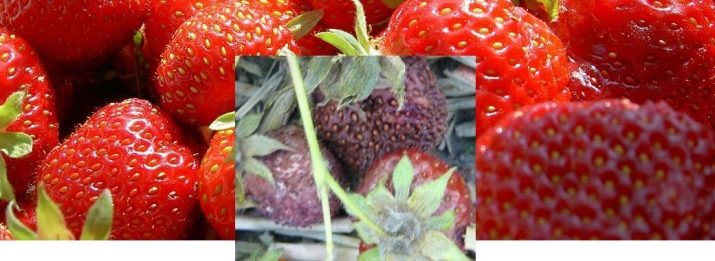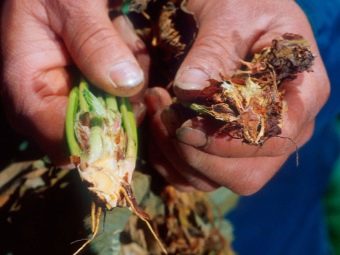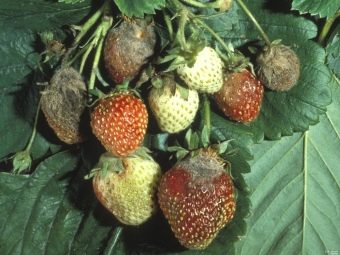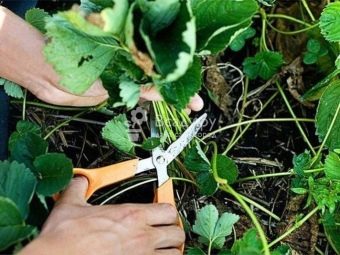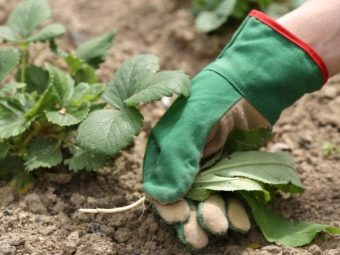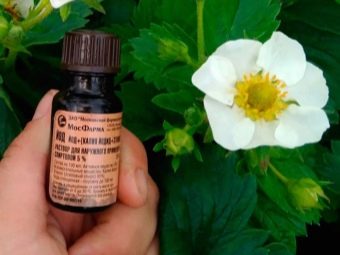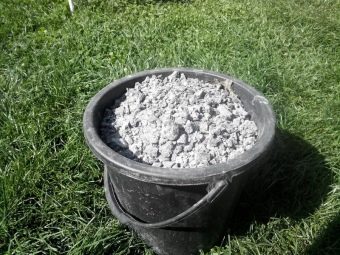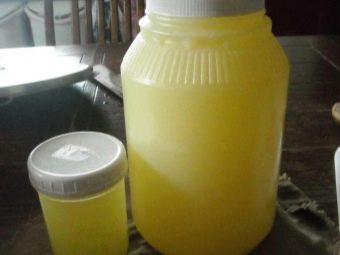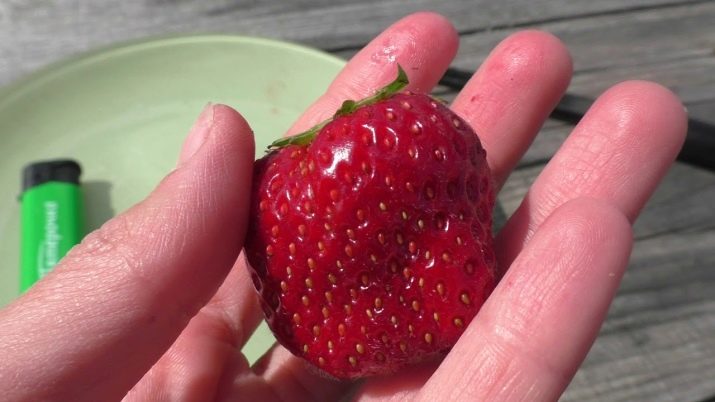Phytophthalosis of strawberries: causes of occurrence and methods of struggle
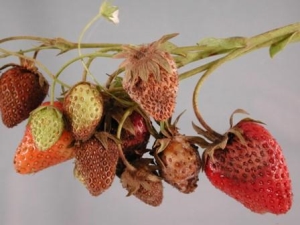
Growing strawberries, many gardeners are faced not only with intrusive pests, but also with all sorts of diseases. One of these ailments is late blight.This is quite a dangerous disease, which is difficult to treat. About its manifestations, methods of control and preventive measures will be discussed in this article.
Special features
Late blight is a fungal disease that can quickly cause crop loss. The forecasts are disappointing: usually about half of the bushes die, and in neglected cases, all at once. Dangerous phytophthora that it moves easily from plant to plant, gradually capturing the entire area.
There are two forms of the disease: chronic and transient.
Chronic
This form is characterized by the fact that the plant does not die immediately. Even ill, it will live for another two years. At the beginning of spring, attentive summer resident will be able to note the underdevelopment of bushes, their stuntedness, short stature. Twisted gray leaves are also a sign of a chronic form of the disease.
The affected bush can bear fruit, but the strawberries will be small and its taste will not deserve high praise. In some cases, fruiting stops altogether, and the leaves dry and fall off.
Transient
Here everything is much worse: the plant dies quickly, within a few weeks or faster. The bush fades dramatically. If you pull it out of the ground, you can find rotten, lifeless roots. Everything is amazed: foliage, stem, roots, sepals, ovaries. Cutting the root, there will be noticeable redness - this is another sign of phytophthora.
Signs of infection
The first sign that the attack attacked the bushes - the appearance of withered leaves, which fall to the ground. During precipitation or cloudy weather with fog, strange spots on the leaves can be noted, usually brown in color, oily to the touch. Already formed foliage becomes stiff and coarse, begins to curl. The ovary, and then the strawberry, becomes darker. At the stage when the disease is treated late, the fruits begin to rot.
It is good that you can notice early and prevent the spread of the disease, because the phytophtora develops gradually.
- First, the disease affects the buds. Flowers darken, and inexperienced gardeners often associate this manifestation with frost. Perhaps this is true, but after the frost the ovary does not form, but with late blight completely.
- Then the attack goes to the berries. Fruits also turn out dark, the bent form. Against a dark background, rare light spots look good. If you cut the strawberries, black rotted pulp is found inside.
- The next stage is the defeat of the roots. The small ones begin to rot and die, the large and strong become bare. The entire root system turns black.
- The final stage is the external change of the plant. The leaves become blue, almost no fruits and ovaries. Shrubs deformed, do not differ in good growth.
Of course, late blight is not taken from nowhere.
Consider the causes that may contribute to the appearance of the disease.
- Infected bushes. When buying seedlings, contact only a trusted manufacturer or a nursery. Grandmothers on the market will sell three times cheaper, but it may turn out that then you have to pay a high price.
- Incorrect landing and non-compliance with the distance. You should not think that a thick, seed-lined bed is the best way to increase the volume of the crop. Nothing but diseases can be obtained.
- Lack of weeding. Weed grass, which grows in abundance among crops, will be an excellent breeding ground for fungus and pests.
- Planting strawberries in the same place. The term of planting culture is three years, then the plot needs to be changed. Also do not plant near plants prone to late blight.
- Lack of dressings. Strawberries are in great need of fertilizers. If you do not take into account this fact, the disease does not take long.
- Use dirty tools. All tools used by the summer resident must be processed, otherwise the disease will be transferred to other cultures.
Treatment methods
To cure late blight, you can use chemicals or use folk remedies.
Chemicals
The best remedy against the disease will be Nitrafen. It is diluted strictly in accordance with the instructions on the package. First, plants that are no longer cured are uprooted, then the soil is treated. The period of "healing" will last a long time, so you have to wait until the bush is completely covered with foliage.
A good solution would be to use products containing copper, for example, Bordeaux mixture, copper oxychloride, Oxych. The plant begins to spray at the first suspicion of phytophthora.
If the gardener noticed the disease too late, you can still try to save the plant. To do this, use strong fungicides: "Horus", "Ridomil", "Topaz", "Kvadris". Handle the bushes until they bloom. When the disease has just begun to manifest, it is better to abandon these drugs and make a choice in favor of more harmless medicines.
Another good tool would be an iodine solution. To make it, mix a bottle of regular iodine with two tablespoons of soda and twenty grams of laundry soap. Dissolve in a bucket of water. Process strawberries until the end of the summer every two weeks.
Folk remedies
Traditional methods will help those who have a negative attitude to chemical additives, and also prefers availability and cheapness.
- Infusion of milk. Take two liters of milk or whey, dissolve in a bucket of water. Spray the bushes with this product.
- Infusion of garlic. Finely chop or chop two hundred grams of garlic in a meat grinder, dilute in a bucket of water and leave for three days. Then pour 30 grams of grated soap into the solution, mix everything up and treat with the composition of the plant.
- Infusion of ash. Take three hundred grams of ash and thirty grams of soap. All this must be diluted in a bucket of water and sprayed with a solution of strawberries.
- Nettle infusion. One and a half kilograms of chopped nettles for a day is poured with a bucket of water. Over time, spray the bushes.
Tips
To never know what blight is, Use useful recommendations from experienced summer residents.
- Perform proper watering. If you fill the bushes, a favorable environment for the fungus. It is better to water in two steps: the first time we water, we wait 15 minutes, we water again. If funds allow, it is better to install automatic irrigation.
- Timely weed the beds, destroy weeds.
- In the spring and autumn clean the area, clean the sick, stunted bushes.
- Do not forget to trim the strawberry tendrils.
- Plant green manure. Such plants as calendula, marigold, phacelia, and buckwheat are well suited for this purpose. Siderats are planted before planting the most strawberries.
- Do not overfeed strawberries with nitrogen. The best time of its submission - autumn, otherwise restrict mineral compositions. Organics contribute once during planting, and then only rotted formulations.
- Choose disease-resistant varieties: Belrubi, Zenit, Boheme, Sakhalin, Cinderella, Zarya.
About what blight and how to deal with it, see below.

